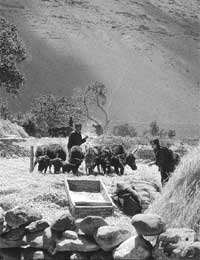Himalayan plunder
 THE book is a compilation of 42 papers contributed by social, physical and environment scientists who are working with issues that confront the Himalayas. The first three papers deal with the conceptual aspects of human ecology in relation to the environment, from the past to the present, and the effects of development on landscapes. Z Baiping discusses the changes that have taken place in the northwestern Tibetan plateau landscape - the montane forests, the shrub lands and the grasslands due to human intervention.
THE book is a compilation of 42 papers contributed by social, physical and environment scientists who are working with issues that confront the Himalayas. The first three papers deal with the conceptual aspects of human ecology in relation to the environment, from the past to the present, and the effects of development on landscapes. Z Baiping discusses the changes that have taken place in the northwestern Tibetan plateau landscape - the montane forests, the shrub lands and the grasslands due to human intervention.
The next five papers cover geo-environmental problems in various states. In Assam these problems are due to unsustainable extraction of rich geological resources; in Arunachal Pradesh, it is due to increasing soil erosion, and in the northwestern Karakorum, due to the threat of floods caused by rapid melting of glaciers that affect the Shimsal settlement.
Four papers deal with biodiversity and ecodevelopment. T C Sarma and S C Nath stress the need to conserve the rich biodiversity that exists in the Northeast, while Z Husain recommends a judicious mix of agriculture, animal husbandry and transhumance for biophysical resource management in high altitude 'hostile' environments. A K Bordoloi discusses the effect of replacement of indigenous trees by eucalyptus in the Brahmaputra valley.
Various aspects of environment and lifestyle in the Himalaya are discussed in 16 papers covering traditional human settlements, their nomadic pattern and health status, some of their arts like weaving and the plants that they use. The Northeast is extensively covered - 13 of the 16 papers in this section are devoted to the region. Many of the papers deal with the practice of shifting or jhum cultivation, and how the shortening of the jhum cycle has come down from the sustainable 30-40 years to 3-5 years. Now the jhum affected forests are unable to meet even the basic needs of the people. The study says that despite some improvement of the health of the people in Ladakh, much more needs to be done to improve health facilities in the region. Health diseases like tuberculosis are widespread.
The final nine papers are devoted to the changes that have occurred. In the past 150 years, urbanisation and development has spread in the higher altitudes of the Himalaya. The collapse of Indo-Tibetan trade after the Sino-Indian war of 1962, the changes in the political set-up, urbanisation and development of communication network have had an impact on traditional lifestyles.
In a study on transhumance, V Bhasin highlights the problems faced in attempts to educate the Gaddis of Himachal Pradesh who are culturally diverse. The worst sufferers in the system, says Bhasin are girls and women. R Khongsdier presents an interesting study on the War Khasis, a sub-group of the Khasi matrilineal tribe which is found in the southern part of the East Khasi Hills district of Meghlaya. They give evidence of the possibility of each village or group of villages possessing a separate gene pool.
While presenting a case-study on the conservation of livestock genetic resources in Kinnaur district of Himachal Pradesh, H R Negi and M Gadgil stress the urgent need of policy changes, including a reduction in the subsidy for chemical fertilisers, so that the people may again depend on organic manure produced by the livestock.
The book points out how in human ecology, everything is interrelated. It provides some insight into the reasons behind various practices that are followed in the Himalaya. As one reads along one gets an idea of how new practices and institutions have altered the thinking - the dependence of villages on their habitat may have decreased, but somewhere along the line the geo-piety which was part of the way of life has been lost. Unfortunately, most of the papers deal with the Northeast, and one is left searching for that elusive book that covers the 12 Indian Himalayan states as well as other countries.
